As more companies adopt hybrid work models, managing office space becomes more difficult. Desk booking systems help solve this by providing real-time information about desk availability. It optimizes space usage and improves the overall office experience.
An office desk booking system allows employees to reserve desks, meeting rooms, or other office spaces based on their needs. It helps businesses create flexible work environments where employees can choose where and when they work.
In this article, we will go over office desk booking systems and their key features. We will also discuss how to choose among the top platforms available and the benefits they can provide to your business.
What Is an Office Desk Booking System?
An office desk booking system is software that allows employees to reserve desks or other office spaces. It provides a way to manage workspaces efficiently by letting users select and book available desks for specific times.
These systems are often used in workplaces with flexible arrangements, especially where employees share desks or work on rotating schedules. It works through a digital platform that employees can access through a website or mobile app. Users can:
- View the office layout on an interactive map
- Check which desks are available
- Book a workspace that fits their needs
The hot desk booking software also shows real-time updates so employees know if desks are occupied or free. Some systems include advanced features like the ability to reserve meeting rooms or request specific equipment, such as dual monitors, standing desks, or ergonomic chairs.
Top 5 Office Desk Booking Systems
Various platforms offer certain features to meet the needs of modern workplaces. From simple desk reservations to advanced analytics and integrations, these systems support businesses in building flexible and efficient work environments.
1. DeskFlex
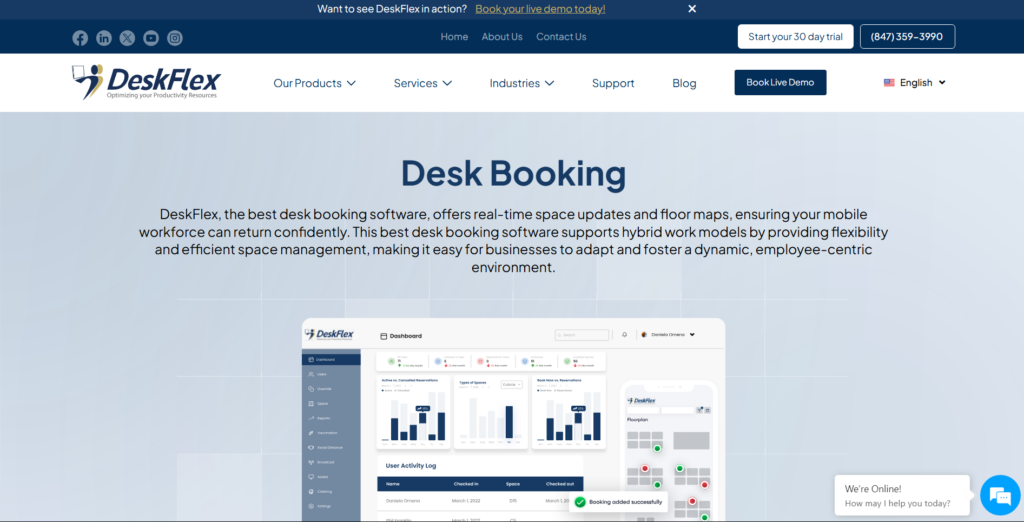
DeskFlex provides tools for desk booking and workspace management. The platform includes features like real-time updates on desk and meeting room availability and interactive floor maps.
Employees can reserve desks or meeting rooms, while office managers can oversee bookings through a central dashboard. The platform also supports hot desking, shift-based scheduling, and visitor management to adjust in hybrid workplaces.
Custom office layouts can be uploaded to help users understand desk and resource locations. The system also includes analytics tools that allow admins to monitor space usage and identify trends.
DeskFlex integrates with Microsoft Outlook, Google Workspace, and Active Directory. It also offers compatibility with other popular workplace tools.
Key Features:
- Real-time updates for desk and room availability.
- Customizable interactive floor maps.
- Hot desking support and visitor management tools.
- Admin dashboard for managing reservations and space utilization.
- Integration with Microsoft Outlook, Google Workspace, and Active Directory.
Improve how you manage office resources with DeskFlex. Book a demo today!
2. Envoy
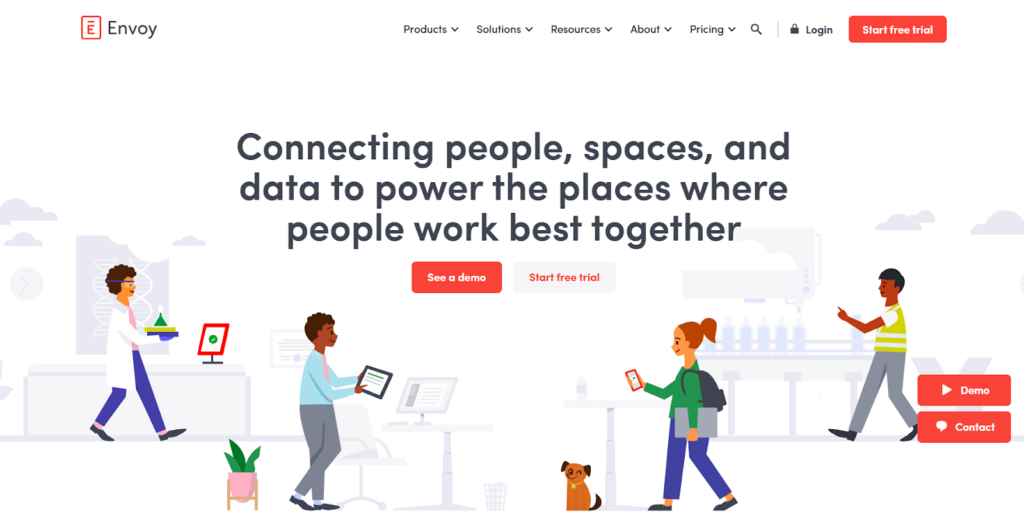
Envoy focuses on flexible seating and workspace management. Employees can reserve desks using the Envoy app and access seating charts to locate available spaces or coworkers.
The platform supports hot desking, desk hoteling, and permanent desk assignments to adjust to different workplace needs.
Envoy allows businesses to group desks into zones for teams to collaborate and organize space use. Desks can be equipped with monitors, docking stations, and other resources.
Real-time maps and seating charts also make it easier for employees to navigate the office and find the right spaces.
Key Features:
- Desk reservations through the Envoy app with seating charts.
- Support for hot desking, desk hoteling, and permanent assignments.
- Desk zones for team collaboration.
- Real-time maps showing desk availability and seating layouts.
3. Skedda
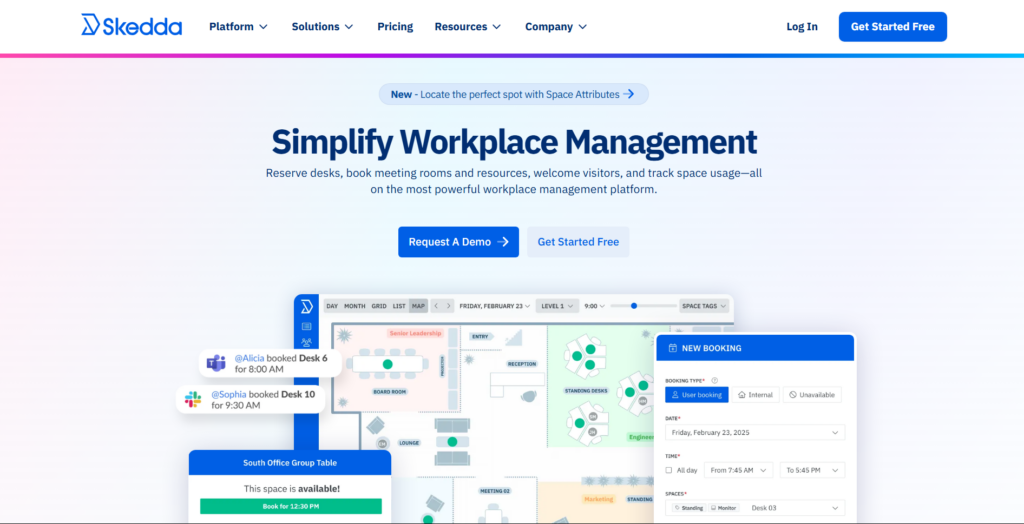
Skedda offers a desk booking solution with tools for workspace organization and employee coordination. Employees can use interactive floor plans to book desks near coworkers or in specific neighborhoods within the office.
The system includes a customizable rules engine that allows businesses to control desk access, quotas, and booking conditions. It integrates with platforms like Slack, Microsoft Teams, and Google Workspace to align desk reservations with schedules.
Its analytics tools also provide data on desk usage to optimize resource allocation in the workspace.
Key Features:
- Interactive floor plans with neighborhood-based desk organization.
- Customizable booking rules, including quotas and access controls.
- Real-time updates on desk availability.
- Integration with Slack, Microsoft Teams, and Google Workspace.
4. Robin
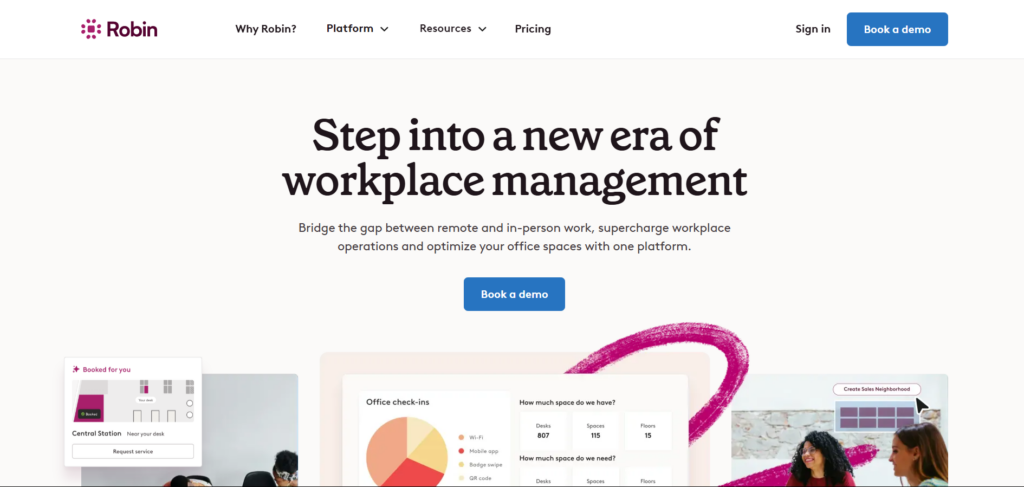
Robin provides a desk booking system with tools for flexible and hybrid workplaces. Employees can schedule in-office days through the Robin app or sync them with Google Calendar.
The platform uses AI to recommend and automatically book desks based on past preferences and bookings. It can also analyze office booking data using custom dashboards to improve layouts and reduce wasted space.
Robin integrates with Microsoft Teams, Slack, and Outlook. It lets users share desk reservations and schedules. Interactive maps and a mobile app help employees see desk availability and locate coworkers.
Key Features:
- AI-powered desk booking based on employee preferences.
- Integration with Microsoft Teams, Slack, Google Calendar, and Outlook.
- Custom dashboards for data analysis and workspace planning.
- Options for multi-day and visitor desk reservations.
5. OfficeSpace
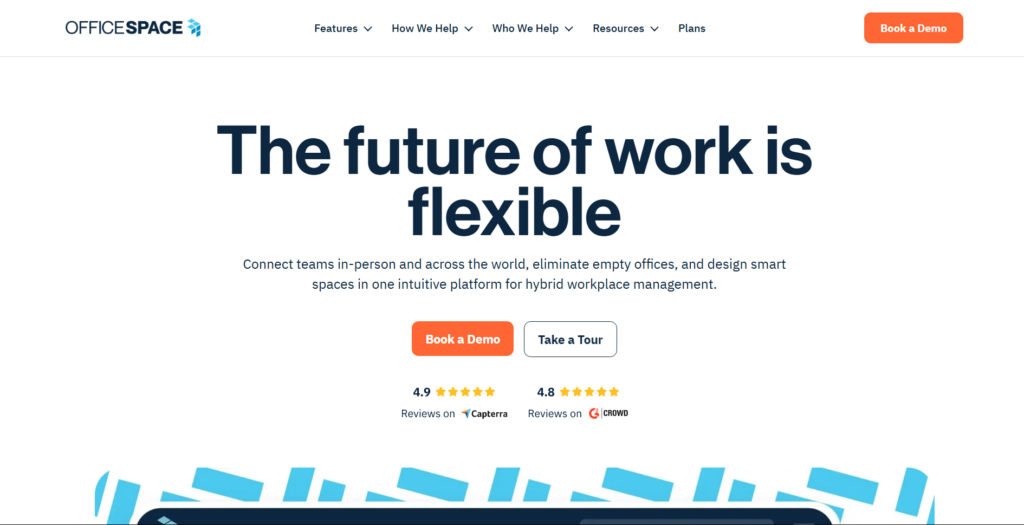
OfficeSpace helps businesses manage workplaces by providing desk reservations and workspace planning tools. Users can reserve desks through Microsoft Teams, Google Workspace, Slack, or mobile apps.
The platform supports hot desking, desk hoteling, and recurring reservations for employees who need consistent access to specific desks. Users can assign monitors, docking stations, and chairs to desks.
Using integrated tools, employees can also locate coworkers and navigate to meeting rooms or desks.
Key Features:
- Desk booking through Microsoft Teams, Google Workspace, Slack, or mobile apps.
- Recurring reservations and saved desk preferences.
- Hot desking and activity-based workspace support.
- Tools for locating desks, meeting rooms, or coworkers.
Key Features of an Office Desk Booking System
An office desk booking system includes features that help businesses organize workspaces and support employees in finding the right resources. These features focus on providing convenience, improving efficiency, and making the office more functional.
Real-Time Availability
Hot desk booking systems display real-time updates about available desks and resources. Employees can quickly check which desks are free and reserve them without confusion. This reduces double bookings and saves time when selecting workspaces.
Interactive Office Maps
Many systems include interactive maps showing the office layout. These maps help users:
- Locate specific desks
- Find meeting rooms
- Create designated quiet zones
Employees can choose spaces near team members. They can also select locations based on their preferences, such as desks with dual monitors or standing desks.
Options for Desk Preferences
Some systems allow employees to select desks based on specific needs. Certain desks may include features like ergonomic chairs, proximity to team members, or quieter locations for focused work.
This flexibility helps employees work more efficiently in the office and improves employee satisfaction.
Integration with Workplace Tools
Desk booking systems often connect with existing systems like:
- Microsoft Teams
- Google Calendar
- Microsoft Outlook
This helps employees coordinate desk reservations with their work schedules and meetings. Syncing these tools allows for better planning and a smoother office experience.
Mobile Access
Many systems offer a desk booking app that lets employees book desks from anywhere. This helps employees plan a hybrid work schedule and check availability while on the move. Mobile access makes desk booking faster and more convenient.
Data and Insights
Desk booking systems collect information about space usage and desk reservations. Workplace leaders can use this data to:
- Identify trends
- Check on areas that are most popular
- Know resources with little usage
These insights help with decisions about office layouts and resource allocation.
Support for Health and Safety
Modern systems include features that address health and safety concerns in the work environment. For example, some systems limit the number of bookings in specific areas to promote safe distancing. Others track desk usage for contact tracing purposes.
Meeting Room Scheduling
In addition to desks, many systems include tools for reserving meeting rooms. Employees can select rooms with the required features, such as:
- Room capacity
- Video conferencing equipment
- Large tables for group discussions
This helps teams stay organized and reduces conflicts over shared spaces.
Access Control for Resources
Certain desk hoteling systems allow admins to assign specific desks or resources to particular teams or employees. For example, a sales team may require access to desks near their department or a meeting room with special equipment. This feature keeps resource usage efficient and fair.
How to Choose the Best Desk Booking System
Selecting the right desk booking tools requires understanding workplace needs, evaluating features, and considering compatibility with existing tools. A well-chosen system helps manage spaces efficiently and supports employees in reserving workspaces with ease.
1. Identifying Office Needs
Start by analyzing how your office operates. Determine the average number of employees working on-site and assess the demand for specific resources like:
- Meeting rooms
- Ergonomic chairs
- Dual monitors
Consider the frequency of remote and in-office shifts for hybrid employees. Understanding these factors helps identify the features your desk booking system should include.
2. Evaluating Key Features
A good desk booking system provides real-time availability, interactive office maps, and tools for reserving resources.
If your office requires features like access control for certain desks or designated quiet zones, look for a system that offers these options.
3. Checking Compatibility with Existing Tools
The system should work seamlessly with the tools your business already uses.
Compatibility with existing workplace platforms and calendar systems avoids disruptions during implementation. Integration with communication tools simplifies the process for employees and admins.
4. Focusing on Simplicity
A straightforward interface increases employee adoption. Systems with intuitive navigation and simple booking processes save time and reduce frustration.
Mobile apps add convenience by allowing employees to schedule desks from any location, which is useful for hybrid work environments.
5. Considering Scalability
Choose a system that adapts to changes in your business. A scalable system should accommodate your needs without requiring frequent replacements or upgrades. This includes:
- Adding more employees
- Increasing office resources
- Optimizing office layouts
6. Balancing Costs With Value
Compare pricing models with your budget, such as flat fees or subscriptions. Look for a solution that balances affordability with features suited to your workplace needs.
You can consider the value the system provides, such as better space utilization and lower operational costs.
7. Using a Trial or Demo
Many providers allow businesses to test their systems through trials or demos. Use this opportunity to:
- Explore features
- Check for compatibility
- Collect employee feedback
Testing helps confirm whether the system matches your workplace requirements.
Why Office Desk Booking Systems are Important for Hybrid Workplaces
Hybrid workplaces are becoming more common. It introduces challenges for managing office spaces efficiently and maintaining a smooth work environment. Desk booking software helps address these with tools that simplify management, improve the office experience, and support flexibility.
Adapting to Hybrid Work Schedules
In hybrid workplaces, the number of employees working on-site changes frequently. Without clear systems, some areas may become overcrowded while others remain unused.
Desk booking systems allow employees to view available spaces in real time and reserve desks ahead of time. This prevents confusion and helps companies make better use of their office space.

Improving Employee Choice and Comfort
Desk booking systems allow employees to choose workspaces that match their needs. Some prefer desks with dual monitors or ergonomic chairs, while others value desks in quieter areas for focused work.
Systems that allow users to pick specific resources or locations help create a comfortable and flexible workspace.
Simplifying Space Allocation
Managing office spaces can be complicated for workplace admins, especially with flexible schedules. Desk booking systems collect and organize data about how spaces are used. This information helps workplace leaders decide how to allocate:
- Desks
- Meeting rooms
- Office resources
For instance, underused areas can be repurposed for group projects or team meetings.
Boosting Workspace Coordination
Many desk booking systems work seamlessly with tools like Microsoft Teams or Google Calendar. It can also integrate with visitor management software to simplify reservations and check-ins. Employees can match their desk reservations with scheduled meetings or other activities.
This reduces scheduling conflicts and helps employees coordinate their in-office days with coworkers. It also improves team collaboration and organization.
Supporting a Flexible Workplace
Desk booking systems help hybrid workplaces function smoothly by offering solutions for varying employee schedules and workspace needs. Employees can:
- Reserve desks
- Access office spaces
- Use desk amenities without delays
These systems provide a practical way for businesses to adapt to the changing demands of modern work environments.
Make Your Workspace Management Better With DeskFlex
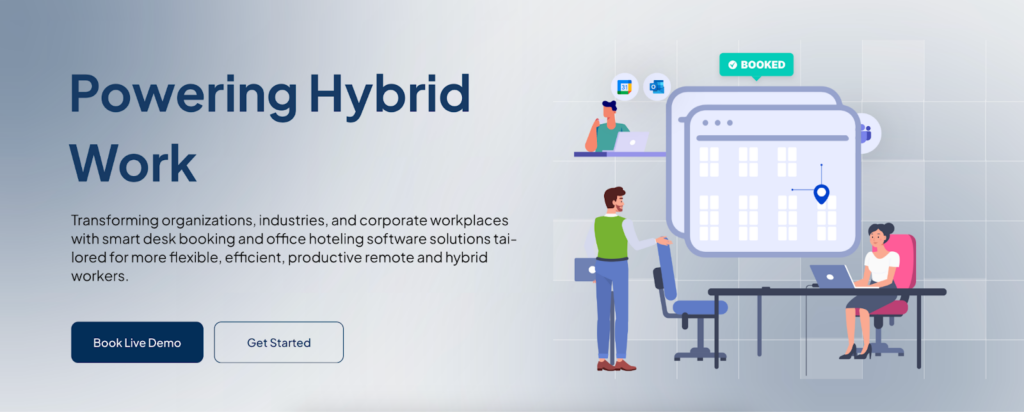
DeskFlex provides a practical solution for managing hybrid offices, optimizing desk usage, and organizing office resources. The platform adapts to your business’s needs.
It offers real-time updates, interactive floor maps, and seamless compatibility with tools like Microsoft Outlook and Google Workspace.
DeskFlex helps businesses create flexible workspaces that meet employee needs and maximize productivity. The system allows you to analyze occupancy data, organize space, and simplify desk and meeting room reservations.
Discover how DeskFlex can optimize the way you manage your office. Book a demo today!
FAQs About Office Desk Booking System
What is an office desk booking system?
An office desk booking system allows employees to reserve desks, meeting rooms, or other office spaces through a digital platform. It helps businesses organize hybrid workplaces by providing real-time updates on desk availability and tools to manage space usage.
How does a desk booking system work?
A desk booking system shows available desks on an interactive platform, such as a mobile app or website. Employees can select and reserve desks for specific times, and some systems provide maps or resource details to help users find suitable spaces.
Who benefits from using desk booking systems?
Desk booking systems benefit both employees and workplace managers. Employees can choose workspaces that suit their tasks or preferences, while managers gain insights into how office spaces are used. This helps businesses organize layouts and resources efficiently.
What features should I look for in a desk booking system?
Key features include real-time desk availability, integration with workplace tools like Microsoft Teams or Google Calendar, and analytics to track space usage. Interactive maps, resource assignments, and options for recurring bookings help businesses meet specific workspace needs.
Do desk booking systems support hybrid workplaces?
Desk booking systems work well in hybrid workplaces. They allow employees to plan their in-office days, schedule desk reservations, and access real-time updates on space availability. Managers can use the system to handle fluctuating attendance and monitor resource usage.

